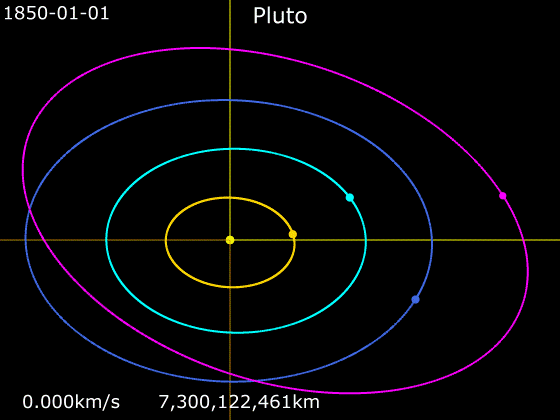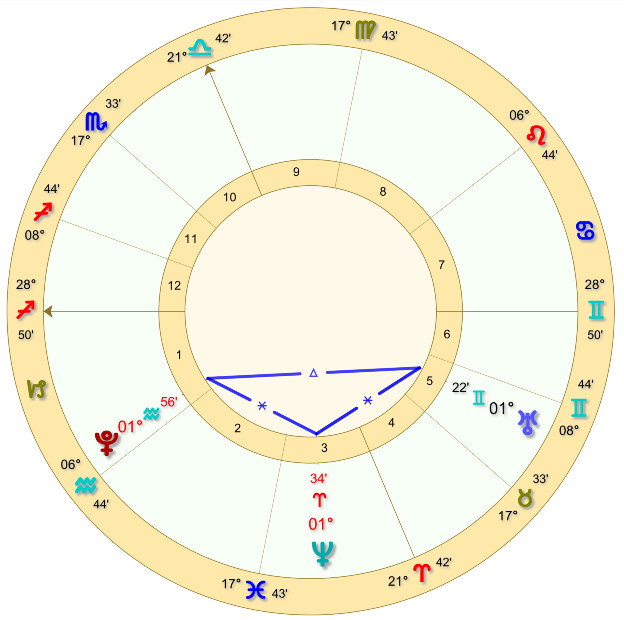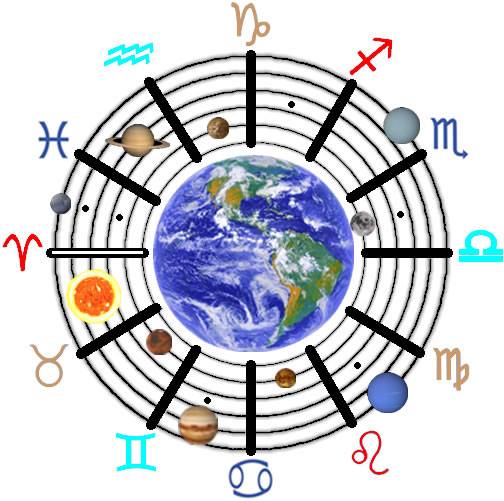Neptune-Pluto Cycle
Pluto (♇) takes roughly 244 years to complete one cycle of the zodiac. Neptune (♆) takes roughly 164 years, about 2/3rds of a Pluto cycle. These two planets are conjunct (♆☌ ♇) about every 500 years, a little more than double Pluto’s cycle. The oppositions between Neptune and Pluto (♆☍ ♇) occur about halfway between conjunctions, 250 years before and after. Therefore, when Pluto returns to the point of the last conjunction, an opposition with Neptune is applying. This point in the zodiac progresses only 3-6 degrees every 500 years, remaining in the same sign for approx. 2,500-year intervals. In 1398AD, the first Neptune-Pluto conjunction in Gemini ♊ occurred, following 2,500 years of conjunctions in Taurus ♉.
The most recent Neptune-Pluto conjunction (♆☌ ♇) occurred in 1891AD at 07° ♊. The next opposition (♆☍ ♇) will occur about 250 years later in 2138AD with Pluto at 10° ♊ and Neptune at 10° Sagittarius ♐. Though no one living today will ever experience one of these two pivotal transits between Neptune and Pluto, we’ve all been steeping in a separating sextile (♆ ∗ ♇) for the past 80 years. Pluto has a highly eccentric orbit and moves relatively quickly for about 100 years, transiting half of the zodiac from Leo to Aquarius ♒. Then it slows down significantly,

taking another 144 years to transit the other half of the zodiac from Aquarius ♒ back to Leo ♌.
100-Year Transits
Though Pluto’s average speed is much slower than Neptune, its top speed is a little faster. As Pluto speeds up in Leo ♌, the distance between the two planets remains relatively consistent until Pluto enters Aquarius ♒ and begins to slow down again. Therefore, any aspect between these two planets is sustained as Pluto transits from Leo ♌ to Aquarius ♒. There’s a consistent pattern in the Neptune-Pluto cycle in which every separating sextile and applying trine is held throughout this period. While most transits between Neptune and Pluto resolve within 5-8 years, these two transits last for almost a century. This phenomenon may account for legends and prophecies of eras of peace and harmony lasting for 100 years.

About 50 years after each Neptune-Pluto conjunction (♆☌ ♇), the 100-year separating sextile begins to form between them. The last ♆☌ ♇ transit occurred in 1891, with the Neptune-Pluto sextile (♆ ∗ ♇) beginning as Pluto entered Leo ♌ in the early 1940s. By the 1950s, Pluto’s speed was roughly the same as Neptune’s, and they would remain in a relatively tight sextile until the mid-2030s. Pluto enters Aquarius ♒ between 2023 and 2024, and as it slows down over the next two decades, this long sextile will finally fade away. But it ain’t over ’til it’s over, and it’s gonna be a wild ride. The last half of this decade will see some of the most significant planetary alignments in hundreds if not thousands of years. 2023 will be a brief calm before the storm, so try to relax and prepare for some bumpy road ahead.

Pluto will be firmly in Aquarius ♒ by 2025 as Neptune enters Aries ♈, followed by Uranus entering Gemini ♊. By late August 2025, as Uranus reaches 01° ♊, it forms an exact sextile with Neptune (♅∗♆) and an exact trine with Pluto (♅△♇). This extremely rare (sextile∗/sextile∗/trine△) configuration between the outer planets has not been exact since 306AD, also with Pluto at 01° ♒. However, there was a loose S/S/T alignment the last time Uranus transited the early degrees of Gemini ♊ from 1940 to 1945. At that time, the 100-year ♆ ∗ ♇ transit was just beginning
with Neptune in Libra ♎ and Pluto in Leo ♌. Uranus aspected both planets, but not simultaneously, never quite forming an exact S/S/T configuration. As Uranus again transits Gemini ♊ beginning in 2025, it will make several exact alignments to both planets.
S/S/T Alignment
The S/S/T alignment can only occur when Neptune and Pluto are sextile (∗) or trine (△) one another. The aspect between them must be exact as Uranus moves in to fill the third position, aspecting both planets simultaneously. Even a loose S/S/T configuration between the outer planets is so rare that there can be nearly a thousand years between them. Before the 1940s, the previous loose SST configuration occurred in 1110AD, and the one before that occurred in 560AD. It’s been 1,820 years since the last exact SST configuration in 306AD. And we’re going to see several exact alignments between 2025 and 2028, with Jupiter (♃) and Saturn (♄) getting intimately involved.

The next time the outer planets form an exact SST configuration will come surprisingly soon in the year 2197AD. Uranus will again be in Gemini ♊ at 20° with Pluto at 20° Leo ♌, similar to the early 1940’s alignment but with Neptune at 20° Aries ♈. With only 170 years between exact SST alignments, this is by far the shortest interval in history. This alignment occurs early in the 100-year Trine between Neptune and Pluto (♆ △ ♇), lasting from roughly 2180AD to 2280AD. The last 80 years have clearly not been an era of peace and harmony, and that’s not going to change any time soon. But the 100-year ♆ △ ♇ transit beginning a little over 150 years from now may bring some much-needed tranquility to humanity.
If we examine the long ♆ ∗ ♇ transit, we can see that it’s been exact many times since the late 1940s and within a few degrees for the first 40 years. Beginning in the 1990s, it dropped below 3°, bottoming out at between 6° and 8° through the 2000s. Since then, the ♆ ∗ ♇ transit has slowly been building to its grand finale, and it promises to be quite a performance. It’s difficult to say what to expect from this period, but we will see hints of the post-WWII and post-Vietnam eras with redux of many of the same cultural phenomena. Neptune represents our deepest beliefs and passions, and Pluto brings new depths of experience to these areas. But unlike previous peaks in the cycle, this time Uranus will keep us on the edge of our seats.
Enter Uranus

Uranus is currently transiting the sign of Taurus ♉, just as it was in the 1930s before entering Gemini ♊ in late 1941. Uranus squared Pluto (♅ □ ♇) in the early 1930s as fascism was beginning to take hold in parts of Europe. Uranus then trined Neptune (♅△♆) beginning an ideological battle over socialism that would last a century. By the mid-1940’s Uranus was sextile Pluto (♅ ∗ ♇) and still in a loose trine with Neptune. This was an exciting period that saw a massive surge in technology, including the development of the first nuclear weapons. After the bombing of Hiroshima and Nagasaki in 1945, the intensity of Uranus began to fade as the ♆ ∗ ♇ transit was becoming exact for the first time.

The early post-war period was overly idealized, as reflected in American television shows and Norman Rockwell paintings. But Uranus came back to square Neptune (♅ □ ♆) in the mid-1950s, stirring up trouble in paradise. This transit brought a lot of gang violence, drugs, and generally rebellious behavior among the youth, blamed mainly on communism or any convenient bogey man. The ♅ □ ♆ transit faded out by the early 1960s, as the ♆ ∗ ♇ transit was loosening. But the Uranus-Pluto conjunction (♅ ☌ ♇) stirred things back up again, beginning in late 1963 with the assassination of JFK and the British invasion just a few months later. Though the ♆ ∗ ♇ transit was no longer exact, the ♅ ☌ ♇ transit and the Uranus-Neptune sextile (♅ ∗ ♆) occurred almost simultaneously.
The Sixties

The 1960s saw the most intense period of the Vietnam war, with anti-war protests becoming increasingly violent and even turning to terrorist tactics. While many were engaged in a political struggle, others sought higher forms of consciousness through meditation and psychedelic drugs. This period blended the excitement of Uranus, the passion of Neptune, and the dark depths of Pluto in a moment we can only affectionately refer to as “The Sixties.” By the ’70s, Uranus had separated from both transits, and the ♆ ∗ ♇ transit was at a low point. If you remember the sixties, you weren’t there. I wasn’t there. But the 2020s will quite possibly make the sixties seem mild by comparison. Don’t believe me? Just watch!
Dazed and Confused

Between the massive failure in Vietnam and the spectacle of the Watergate hearings, the 1970s was a time of disillusionment for many. However, it was another post-war period of relative peace and stability lasting into the early ’90s. The ♆ ∗ ♇ transit peaked again from the late ’70s to the late ’80s, beginning a sharp decline in the ’90s. Uranus made another dramatic entrance at the end of the ’80s with a conjunction to Neptune (♅ ☌ ♆), followed by a sextile to Pluto (♅ ∗ ♇). Uranus and Neptune both entered the sign of Aquarius ♒ from the mid to late ’90s during the height of the ♅ ∗ ♇ transit. This period saw more wars and terrorism, as well as a spiritual resurgence affectionately called the “New Age.” If you remember the 90’s, you probably were there. I remember the 90’s, but it’s a bit fuzzy.

In the 1960s, Uranus was conjunct Pluto (♅ ☌ ♇), which is one of the most volatile transits possible. At that time, Uranus was also sextile Neptune (♅ ∗ ♆), bringing in exciting new paths to spiritual enlightenment. But the ♅ ☌ ♆ transit in the ’90s wasn’t nearly as dangerous. On the positive side, it brought a much-needed reverence for life after the New Wave fad of the ’80s. But on the darker side, we saw a massive surge in religious fanaticism, bringing a wave of foreign and domestic terrorism. By the end of the ’90s, the ♅ ☌ ♆ transit had faded entirely, but the ♅ ∗ ♇ transit was still within orb. But as Uranus separated from Pluto in the early 2000s, the ♆ ∗ ♇ transit was at its loosest point in 50 years.
Post 9/11 Era
The events of September 11th, 2001, deserve a more detailed approach with more planets included. But for the sake of brevity, in attempts to sum up a century, we’re only looking at the outer planets. As we woke up to the news on the morning of 9/11, we found ourselves reaching back to the WWII era for some parallel to the sense of gravity we collectively felt. We forget how grave a situation can be until we find ourselves in one of these dark moments in history. The periods when the ♆ ∗ ♇ transit was strongest seemed to be preserved in a buoyant optimism and levity. It almost appears as though gravity suppresses levity or that levity wards off gravity.

Either way, the world had changed on that day, and our collective innocence was lost. We can see a clear depression in the outer-planetary activity between 2002 and 2008, just before the onset of the Uranus-Pluto square (♅ □ ♇). Beginning around 2011, it seemed as if every corner of the world was in open revolt. From the Arab Spring to the Mid-West uprisings, liberals and conservatives alike were out in the streets demanding justice; however they defined it. As the Occupy Wall Street movement spontaneously spread around the globe like wildfire, the protests became increasingly non-partisan. However, OWS suffered a lot of power struggles with many pre-existing groups seeking to co-opt the spirit of the movement.
That spirit was short-lived for those in the US as the long presidential election season began the following spring. Most people went back to their corners, identifying with their political parties and their chosen candidates. The ♅ □ ♇ transit brought a wave of extremism leading from one presidential election to the next. We also learned a lot of disturbing information about how the surveillance state was using our technology. This period was the peak of the American drone assassination program, though it was being hidden from the public. Whenever Uranus and Pluto get together, we can expect to unearth some exciting, if not troubling, information. Uranus is the planet of technology and the problems it brings.

By 2020, the ♅ □ ♇ transit had faded entirely, while the ♆ ∗ ♇ transit was slowly fading back in for a third and final pass. The last five years have been increasingly focused on what we believe, who we believe, and what we refuse to believe. As the levity returns, we cannot help but make fun of flat earthers, anti-vaxers, and any conspiracy theorists spouting nonsense. But we must admit that we don’t know everything, and we too are choosing who and what to believe. We’ve been stuck in an ideological battle that has lost all meaning, choosing to meet bias with bias instead of seeking a more balanced and nuanced approach. We may not know it, but we’ve been searching for something real, something worthy of our belief.
The Late 2020’s

This period also deserves a more in-depth look, and we’ll be doing just that in The Aquarian Age Blog and Podcast Series. But in the context of the 100-year ♆ ∗ ♇ transit, this is by far the most exciting moment. We’re already starting to feel the alignment between the outer planets forming as Uranus begins a trine with Pluto (♅△♇), and a sextile with Neptune (♅∗♆). This decade could herald a time of technology in harmony with nature, possibly triggering a leap in our evolution. We may see a resurgence of spiritual enlightenment with minimal overtones of religious fundamentalism. Those who remain on the fringe may finally go over the edge completely, but not in a way that disturbs our collective opportunity for growth.

As Pluto enters Aquarius ♒ between 2023 and 2024, we’ll begin to see a noticeable change in our collective values. In early 2025, Neptune will enter Aries ♈ followed by Uranus entering the sign of Gemini ♊. Later that year, we see the first exact configuration between the outer planets. We’ve had these transits independently in history, but this is the first time in almost 2,000 years that we’ve experienced them simultaneously. It’s as though we’ve been listening to music played slightly out of tune our entire lives, and suddenly, someone tunes the instrument for the first time. We can be pleased to know that these intervals are harmonious and overwhelmingly positive, representing an opportunity for all of humanity.
End of an Era

Uranus will again duck out by the end of this decade, only to return at the end of the 2030s. As the long ♆ ∗ ♇ transit finally fades out, we have one more Uranus-Neptune square (♅ □ ♆) lasting from the late ’30s through the early ’40s. We can expect many ideological battles from the 1950’s era to resurface and hopefully to resolve. At that time, the rebel archetype was idolized and idealized in celebrities like Elvis Presley, Marilyn Monroe, and James Dean. We can expect new larger-than-life archetypes from this era, as the century-long ♆ ∗ ♇ transit separates for another 500 years. After two decades in the sign of Aquarius ♒, Pluto will enter Pisces ♓ in the year 2043 and the long ♆ ∗ ♇ transit will finally fade out like an old song.
In The Aquarian Age Blog and Podcast Series, we’ll continue to explore this fascinating period and beyond. We cannot be sure what the future will bring, but we can peek at the sheet music.
Click Here for a detailed Transit Timeline of outer-planetary events from 2020-2030.

